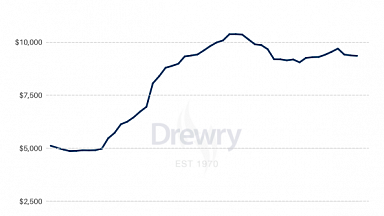For nearly six months, Yemen’s Houthi fighters have been disrupting global supply chains. In December 2023, they began firing on ships headed to Israel or operated by Israeli entities to show solidarity with the Palestinian population in the Gaza Strip. Yemen controls the Bab al-Mandab Strait, which serves as the gateway to the Red Sea and leads to the Suez Canal.
About 12% of global trade and 20% of global container traffic pass through the Suez Canal. Because of Yemeni fighters, many major shipping companies have suspended travel through the canal, diverting ships from Asia to Europe around the Cape of Good Hope, which adds about 10 days to the journey.
This longer route means higher costs for shipping lines. The detour around Africa increases fuel costs by 40%, according to Maersk. The attacks have also extended further into the sea, prompting ships to lengthen their routes. German shipping company Hapag-Lloyd is currently avoiding the Gulf of Aden entirely.
Meanwhile, the French operator CMA CGM continues to sail through the Red Sea and Suez Canal, escorted by the French Navy. Despite this, a significant portion of their fleet has been redirected to Africa. According to Bloomberg Intelligence estimates, traffic through the Suez Canal is down by 80% year-on-year due to the Red Sea crisis.
Surge in Container Rates
The Red Sea crisis has led to a sharp increase in container rates, which had declined throughout 2022 and 2023 following a pandemic-related surge. Last autumn, container rates were roughly at pre-COVID-19 levels. On December 1, 2023, the Baltic Freightos index for the Asia-Northern Europe route was $1,243.
By the second week of 2024, it had risen to $4,391. The index settled at around $3,200 at the end of March and currently stands at approximately $3,550—almost three times higher than before the crisis. Rates to Mediterranean ports also surged from $1,670 at the start of December to $5,168 at the beginning of January. The index currently rests at $4,445.
Container Shortages Persist
Despite Western ships patrolling Yemen’s waters, the Red Sea crisis continues. Maersk forecasts that transport capacity between Asia and Europe will shrink by 15-20% in the second quarter of this year.
The problems in the Red Sea have created a domino effect on the alternative route to Europe. Ships have to stop at African ports to replenish increasingly expensive fuel, causing congestion when multiple vessels dock at the same time. Congestion also affects the Port of Tangier, where cargo is transhipped to the Mediterranean and Northern Europe.
«Tangier is already saturated, so we need to consider alternatives such as Algeciras or Valencia,» said Rodolphe Saade, President of CMA CGM, in an interview with Le Monde.
Longer journeys and port congestion mean containers do not return to Asian ports as quickly, resulting in shortages. Maersk has rented an additional 125,000 containers and stated, «We are doing everything we can to increase reliability, speed up travel times, and add extra capacity.»
Surcharges for Increased Costs
Maersk customers can expect additional surcharges to cover increased costs associated with longer routes, faster travel speeds, and higher fuel prices. «We currently use 40% more fuel per voyage, and charter rates have tripled, often locked in for five years,» Maersk stated.
After a recent reduction in the Peak Season Surcharge, Maersk was forced to raise it again to cover the extra costs.
Rising Rates
This isn’t good news for importers, who have already seen rising rates in recent weeks. On May 9, Drewry’s WCI index stood at $3,159 for a 40-foot container, a 16% increase over the previous week. The Shanghai-Rotterdam route index jumped by 20% to $3,709, up $700 in just two weeks. The index for the Shanghai-Genoa route also rose by 16% to $4,295. Further increases are expected.
Impact on Other Routes
The additional surcharge will affect European importers, including those in Poland. The shortage of containers is also impacting routes other than those through the Suez Canal.
CMA CGM announced that, effective May 17, it will implement an Empty Repositioning Surcharge (a security fee to cover losses due to container shortages) on routes from Turkish Black Sea ports to Scandinavia, Northern Europe, the Baltic States, the UK, and Poland. The surcharge will be €150 for a 20-foot container and €200 for a 40-foot container.
Prolonged Crisis
Maersk expects the Red Sea crisis to persist until at least the second half of the year, possibly extending into 2024. At a recent conference, Hapag-Lloyd CEO Rolf Habben Jansen expressed optimism that the crisis will end before the year’s close.




